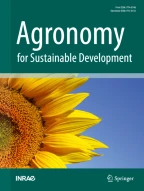
Climate change is increasingly affecting agriculture worldwide, causing yield losses and undermining food security. Behind the international consensus on the urgent need for ambitious policies to adapt agriculture to climate change (AACC) hides a competition between three agricultural models—agroecology, climate-smart agriculture, and conventional agriculture—each carrying distinctive perspective on how agriculture should adapt to climate change. To date, no study has shown which of these three agricultural models is promoted the most by climate change adaptation policies. To shed light on this question, we undertook semi-structured surveys with resource persons, a literature review and a multi-criteria analysis, identifying and characterizing 226 AACC policy initiatives in seven countries or regions in the north (Andalusia, Occitanie, California, Guadeloupe) and the south (Colombia, South Africa, Senegal). Our aim was to identify (1) concrete strategic options mobilized by policy initiatives to adapt agriculture to climate change and (2) agricultural models that are implicitly or explicitly promoted by these policy initiatives. We identified 14 climate change adaptation options that mobilize a set of three complementary levers of action: (i) transforming production systems or enabling access to productive resources, (ii) providing access to knowledge that is useful for AACC, and (iii) coordinating and financing adaptation actions at territorial or sector scale. Agroecology and climate-smart agriculture are the two agricultural models favored in the mix of policy initiatives in all the studied sites. Despite conceptual differences, in real-life situations, these models do not conflict with each other since they are often promoted concomitantly. AACC policy initiatives, although diversified, seem too fragmented and not sufficiently restrictive to bring about rapid and profound change. This paper presents a new classification of AACC adaptation options, and is the first to reveal which agricultural models are promoted by policy initiatives in a wide range of regions.
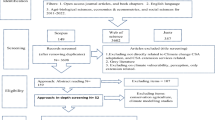
Avoid common mistakes on your manuscript.
In many parts of the world, agriculture is already experiencing the full impact of climate change, with yield losses that impact the economy and undermine food security in the short, medium, and long terms (Bezner Kerr et al. 2022). Climate change comes in the form of higher temperatures, changes in precipitation patterns, and increasingly frequent extreme weather events (IPCC 2014). Recent analyses show that climate change is accelerating, increasing the risk of disasters in terms of both magnitude and frequency (IPCC 2022). The agriculture sector is particularly vulnerable to climate change because production is primarily influenced by climate and weather factors. The impacts of climate change are both direct (crop and livestock productivity) and indirect (changes in food availability and prices, reduced farm incomes). Climate change threatens all aspects of food security, i.e., food supply, access, use, and price stability (FAO 2016; Gregory et al. 2005; Khanal et al. 2021). It affects the world’s most vulnerable countries, regions, and population groups most severely (IPCC 2022).
In response to this worrying situation, policy initiatives for the Adaptation of Agriculture to Climate Change (AACC) have proliferated around the world (Ford et al. 2015; Berrang-Ford et al. 2021). Since the 2000s, adaptation of agriculture to climate change and mitigation of its impacts have become a priority on national and international agendas (Lesnikowski et al. 2016; Von Lampe 2022). The Kyoto Protocol and the 2015 Paris Agreement set targets for reducing greenhouse gas (GHG) emissions and promoting more sustainable forms of agriculture that take climate change into account. Official strategies have thus aimed to alter the course of the farm sector in the face of climate change.
Climate change adaptation strategies are generally designed and implemented by governments and other actors through public investments, projects, programs, instruments, actions, and interventions. In this article, we refer to these heterogeneous elements as “policy initiatives”. Previous research on policy initiatives for climate change adaptation falls into two categories:
In this paper, we use a different lens to look at climate change adaptation policy initiatives, to identify the adaptation options proposed, and whether one agricultural model in particular is promoted. This issue is in fact highly controversial: the international consensus on the need to achieve profound changes in our agriculture in fact masks competition between three agricultural models—climate-smart agriculture, agroecology, and conventional agriculture—that all claim to respond to the challenges of adaptation to climate change (Bezner Kerr et al. 2022; FAO 2016; Hrabanski and Le Coq 2022; Torquebiau 2017):
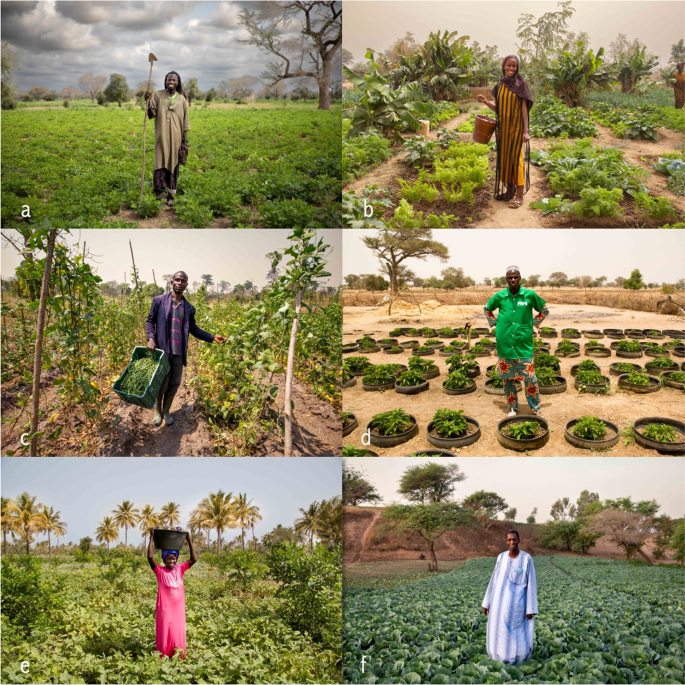
Although many authors point to the interest of politically supporting one or the other of the three approaches, to date, no study has shown which of these three agricultural models is promoted the most by climate change adaptation policies.
For this purpose, we performed a cross-sectional analysis of 226 policy initiatives in seven different countries or regions, in the south (South Africa, Senegal, Colombia) and in the north (Andalusia in Spain, California in the USA, and the French regions Occitanie and Guadeloupe), with the aim of identifying the adaptation options and the main agricultural models conveyed by these initiatives, if any. The case studies were selected to obtain contrasted climate contexts, “levels of development,” and agricultural sectors. We hypothesized this would provide contrasted study sites in terms of climate vulnerability (Füssel and Klein 2006), adaptive capacities (Eakin et al. 2014), and policy mix. By “policy mix,” we mean a set of government policies which, by design or by fate, interact to shape R&D and innovation systems (Flanagan et al. 2011; Rogge and Reichardt 2016). The choice of study sites was also guided by the partnership set up for the “Typoclim” project, of which this study was part. Table 1 lists the specific features of each study site.
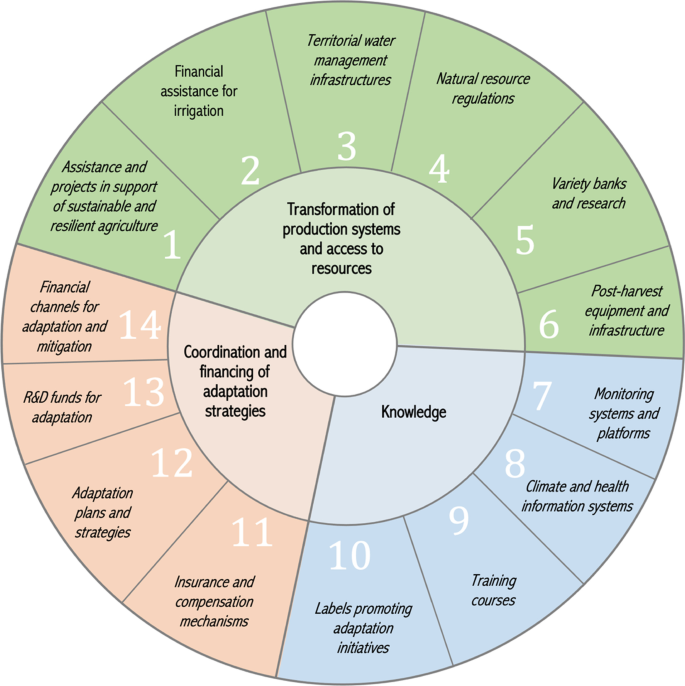
A number of policy initiatives are intended to transform agricultural production systems to make them more agronomically and economically resilient to the different facets of climate change (increasing temperatures, extreme events, changing rainfall patterns, invasive pests). One aim is to guarantee access to—and the sustainable use of—productive resources threatened by climate change, such as water and agrobiodiversity.
Category 1 groups financial assistance and projects aimed at encouraging a transition towards sustainable and resilient agriculture in the face of climate change. Regional, national, or international public institutions provide individual or collective grants for varietal conversion to using cultivars adapted to climate change, farm greening (reforestation, reduced use of crop chemicals, non-productive land management, etc.), or conversion to and maintenance of organic farming. For example, in California, the Environmental Quality Incentive Program provides federal cost-share grants to implement conservation agriculture, a production model to match good agricultural yields with environmental protection. Other projects combine economic incentives, equipment, and training to support a transition towards agroecology, agroforestry, or the adoption of varieties adapted to climate change. For example, between 2007 and 2012, the Groundnut Basin Degraded Land Management and Restoration Project in Senegal funded operations to improve agricultural soil management and develop income-generating activities.
Category 2 groups financial assistance and projects to provide farmers with irrigation equipment while simultaneously promoting water saving. These include grants, loans, and subsidies that enable farmers to obtain or maintain irrigation equipment and small water management structures, including wells, pumps, collection devices, reservoirs, irrigation systems, and dykes. The different types of assistance target individual farms or groups of farmers and mainly concern small-scale equipment. For example, the State Water Efficiency and Enhancement Program in California provides financial assistance to farmers in the form of grants to install irrigation systems that save water (e.g., drip irrigation). There are also development projects that finance equipment and structures while training farmers in water management.
Category 3 groups policy initiatives designed to extend irrigable areas in places where rainfed crops are being affected by climate change. These are programs, projects, schemes, or measures for the construction or restoration of major water structures (dams, hydraulic transfer networks, desalination plants, etc.). These projects are implemented under the supervision of public institutions and aim to increase the availability of water in a given area. In Occitanie (a region in mainland France), for example, the Aqua Domitia project involves constructing a large network of pipes to divert water from the River Rhône to areas at risk of drought.
Climate change and human activities affect the quality and available quantity of water and natural resources (IPCC 2014). Category 4 groups regulatory policies for good water management and conservation, such as framework decrees, directives, decrees, plans, programs, legal codes, memoranda, and taxes. These are implemented by governments to regulate the use of water resources or to regulate agricultural practices that can pollute water. Examples include (i) permanent water use quotas; (ii) temporary restrictions on water use in the event of drought, which are sometimes modulated according to the severity of the drought; and (iii) restrictions or bans on pumping in sensitive areas (e.g., water catchment protection schemes, aquifers in danger of saltwater intrusion). Regulations are often the means by which governments implement their international commitments (e.g., Sustainable Development Goals, Agenda 21, Paris Agreements). In Senegal, for example, the water code limits withdrawals (i) in catchments where the groundwater is approaching its limits; (ii) in catchments where the resource is channeled through a public water distribution service; and (iii) in catchments where there is a potential danger of saltwater intrusion.
With climate change, the crop varieties the farmers normally use may prove to become unsuitable. Changes in precipitation and temperature regimes may disrupt cropping calendars and cause biotic and abiotic stresses that reduce yields and increase the vulnerability of a given production system (Ndour et al. 2017; Tidjani and Akponikpe 2012). This has been observed with many varieties of wheat, cotton, maize, and rice. Category 5 groups projects and programs designed to conserve, analyze, breed, and disseminate plant material adapted to climate change. Gene banks are funded to preserve seeds of different origins so they can be used in plant breeding or variety selection programs. Projects and programs generally aim to develop varieties that are resistant to drought and to bio-aggressors. For example, the mango germplasm bank in Colombia is used to conserve endangered varieties and to select cultivars suitable for use under climate change.
Extreme climate events (floods, heatwaves, etc.) combined with inadequate storage conditions can lead to loss of foodstuffs after harvest. Category 6 groups projects to help farmers acquire post-harvest processing and storage equipment and infrastructure. This helps improve farm income and resilience by enabling (i) access to crop storage facilities that are protected from extreme climate events; (ii) pre-storage processing (e.g., drying, threshing or cleaning) for better storage; (iii) enabling products to be sold when prices are most advantageous; and (iv) combining several farmers’ harvests to increase bargaining power with buyers (Taruvinga et al. 2014). For instance in South Africa, the projects “Khulisa” from the Western Cape Government and “AgriParks” from the National Department of Rural Development and Land Reform were designed to encourage agro-processing businesses and investments in adaptation to climate change.
Knowledge-based initiatives are designed to produce and disseminate knowledge that is considered useful for farmers’ adaptation strategies and for coordination between actors (policy makers, development agents, experts, etc.) involved in the implementation of AACC policies.
Category 7 groups multi-stakeholder platforms and monitoring systems that centralize, capitalize, and disseminate information useful for AACC. Multi-stakeholder platforms bring together a range of stakeholders (farmers, agricultural advisers, experts, decision-makers, etc.) to exchange and disseminate agroclimatic information. These platforms also enable stakeholders to network, which helps create synergy between their different actions. Finally, the platforms serve as a bridge between stakeholders in the field and decision-makers located elsewhere, enabling AACC issues to become part of the political agenda. Agroclimatic round tables in Colombia, for example, bring together actors of the farm sector to produce and distribute a monthly information bulletin with recommendations for each crop. Monitoring systems are set up by scientists and experts who centralize, analyze, capitalize, and disseminate information about the climate and AACC. Monitoring systems provide expert services such as regional climate analyses. For example, in Occitanie (a region in France), two regional monitoring systems (called ORACLE and Clima-XXI) provide regional climate diagnoses and forecasts at different time horizons.
Category 8 groups Climate Information Systems (CISs) and Information and Communication Technologies (ICT) aimed at informing stakeholder decision-making in the face of climate variability and instability. CISs disseminate climate and agronomic information (weather forecasts, pest warnings, natural resource monitoring data, etc.) to farmers and public-sector players through internet platforms or mobile phone applications. This information is used (i) by farmers to foresee extreme events and optimize crop management according to weather trends and (ii) by decision-makers to prepare emergency interventions and to adjust agricultural policies, plans, programs, guidelines, and recommendations for AACC. Unlike category 7 platforms, which rely on expertise and synergy between actors to guide strategic decisions, category 8 initiatives primarily rely on digital tools to disseminate information for adaptation actions, often on a weekly or daily basis. For example in Senegal, climate/weather data is collected by the National Meteorological Agency and communicated to farmers via text messages, voice messages, or community radios. Category 8 ICTs bring together a set of technologies (IT, audiovisual, internet, phone apps, drones, etc.) to help farmers make decisions by providing information on economic aspects, agriculture, weather/climate, crop health issues, and policies. Among the policy initiatives listed in our study, several ICT-based projects are designed to improve the economic and environmental performance of farms in a situation of climatic instability. In Andalusia (Spain), a mobile app developed by the Ministry of Agriculture, Fisheries and Food provides access to real-time data on rainfall and evapotranspiration, enabling farmers to assess their net water needs.
Category 9 includes initial or continuing education courses for producers, agricultural advisers, and agricultural executives. These training courses are organized by different categories of stakeholders (governments, international institutions, NGOs, etc.) and disseminate information on climate change impact and adaptation strategies. The courses include the following: (i) Master’s courses that incorporate the issue of AACC. For example in Senegal, the “Adaptation of Agricultural Practices to Climate Change” Master’s course trains experts in climate risk analysis and implementation of adaptation/mitigation policies. (ii) Seminars and lectures to train and inform farmers on AACC issues; (iii) farmer groups who share their experiences at workshops or visits to farms, like the Dimitra listeners’ clubs in Senegal created by the FAO; (iv) trial plots used as a training and networking support for producers involved in an AACC approach, such as the farmer field schools in Colombia.
For farmers, adaptation to climate change requires technical changes and sometimes costly investment in equipment (Dugué et al. 2012). Category 10 groups labels to promote products or farms engaged in sustainable agriculture or climate change mitigation or adaptation. These labels enable consumers to support farms that operate on a sustainable basis. Users of these labels can get higher prices than their competitors, which they need to offset transition costs. For example in Spain, the “Wineries for Climate Protection” label for the Andalusian wine industry highlights wineries that are reducing their production of waste, consumption of water, and greenhouse gas emissions.
Lastly, some policy initiatives are designed to finance adaptation strategies or to coordinate adaptation initiatives in a given territory or sector.
Category 11 groups financial mechanisms (insurance, emergency funds, agricultural subsidies, etc.) to compensate for the impact of climate change and extreme events on farms. The purpose of agricultural insurance is to protect the market value of crops against natural disasters by covering climate risks (e.g., multi-risk insurance, hail/storm insurance). This insurance is sometimes conditional on compliance with good agricultural practices. For Occitanian wineries, exemption from the production ceiling under the “individual additional volume” system is a way to guarantee both the harvest and the quality of the raw material produced. Subsidies make it possible to compensate for the additional production costs caused by climatic events, by allocating funds or planting material (e.g., seeds) and/or by helping farmers take out agricultural insurance. Finally, emergency funds are monetary funds released after a climatic event that has caused pre- or post-harvest losses or prevented sowing. These funds provide financial assistance to farmers whose crops sometimes cannot be insured. For example, in Guadeloupe, a French island region in the Caribbean, farmers affected by natural disasters receive monetary assistance under the Specific Options Program for Remoteness and Insularity.
Category 12 groups plans and strategies aimed at coordinating adaptation actions at various scales. Governments set up national or regional plans for adaptation to climate change. These plans involve a variety of measures (research, information dissemination, platforms, development, etc.) for such sectors as crop farming, livestock raising, fisheries, and energy production. They are often based on a diagnosis of vulnerability to climate change. For example, national climate change adaptation plans exist in Colombia, France, Senegal, and Spain. Also, some well-structured agricultural sectors create their own AACC plans, like the Sustainable Banana Plan in Guadeloupe (French overseas region). This plan consists of promoting a set of agricultural practices to make banana production systems more resilient to climate change, including weekly leaf stripping, use of cover crops, and the use of organic fertilizer.
AACC requires significant Research and Development (R&D) efforts, whether to better understand the manifestations of climate change or to design and test solutions. Category 13 groups policy initiatives that finance and catalyze R&D projects for adaptation to climate change. These initiatives come in the form of funds that encourage the emergence of innovative projects through calls for tenders in diverse fields such as mapping, varietal development, pest control, and cropping innovations. The funds are sometimes managed by incubators or technology platforms that encourage networking among R&D players (laboratories, private companies, producer organizations, etc.) to speed up innovation for AACC. For example, in Guadeloupe (French overseas region), the Agricultural Innovation and Transfer Networks fund research and innovation projects on market gardening and sugarcane growing practices, such as the use of service crops.
Producers who wish to invest in increasing the resilience of their farms often find it hard to obtain loans. Financial institutions do not want to risk lending money to farmers because of the climatic risks they are subject to. Category 14 groups financial channels geared to AACC projects. For example, funds are granted to financial institutions like banks, insurance companies, and microfinance institutions to encourage them to fund investments by stakeholders in the farming world. One example is the AGreenFi agriculture funding label of the French Development Agency in Senegal. Other examples of financial channels are carbon markets and carbon taxes. Carbon markets set a cap on carbon dioxide emissions and allow players to trade emission rights in the same way as financial securities. A carbon tax sets a price for carbon, implying payment based on the level of emissions. The funds collected by these two mechanisms can then be used to finance adaptation and mitigation projects.
Principal component analysis (PCA) (Fig. 3a), ascending hierarchical classification (Fig. 3b), and Table 2 were used to identify the agricultural models promoted by the 226 policy initiatives in our dataset. The first two factorial axes of the PCA explain 61% of the data. Factorial axis 1 compares the variables “climate-smart agriculture” (CSA), “agroecology” (AE), and “conventional agriculture” (CA) with the “neutral” variable, while factorial axis 2 compares agroecology with conventional agriculture. The conventional agricultural model contrasts with that of agroecology, while climate-smart agriculture is positively linked to both agroecology and conventional agriculture.
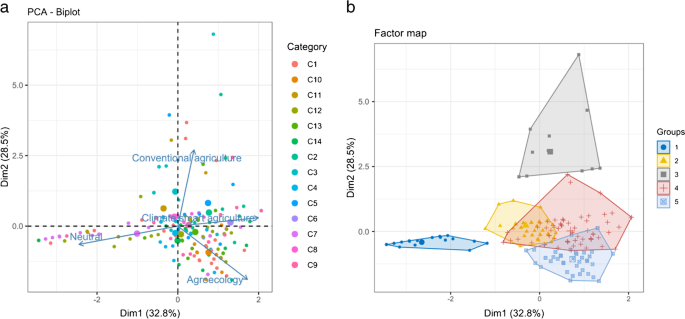
Table 3 shows that climate-smart agriculture (CSA) and agroecology (AE) are the adaptation models by far the most frequently promoted by the policy initiatives in our dataset. Some policy initiatives promote both these models (cluster 4 in the hierarchical ascending classification shown in Fig. 3b), although the relative weights of agroecology and climate-smart agriculture vary depending on the category. The policy initiatives that promote climate-smart agriculture (cluster 2) are mainly climate and health information systems, insurance and compensation mechanisms, seed banks and varietal research, and assistance for irrigation (categories 2, 5, 8, 11 of the functional typology). Initiatives that promote agroecology (cluster 5) are the most numerous. These are mainly financial assistance and projects in support of sustainable and resilient agriculture, regulations on natural resources, post-harvest equipment and infrastructure, and labels and financial channels for adaptation and mitigation (categories 1, 4, 6, 10, 14). Conventional agriculture (cluster 3) is rarely promoted by AACC policy initiatives. However, there are some cases of financial aid and projects aimed at improving the availability of water or inputs for agricultural operations (categories 2, 3, 5). Finally, some policy initiatives do not promote a particular agricultural model. These neutral initiatives (cluster 1) mainly play a role in disseminating information or coordinating adaptation actions: monitoring systems and platforms (category 7), and plans and strategies (category 12). There are also neutral financial instruments (categories 13 and 14).
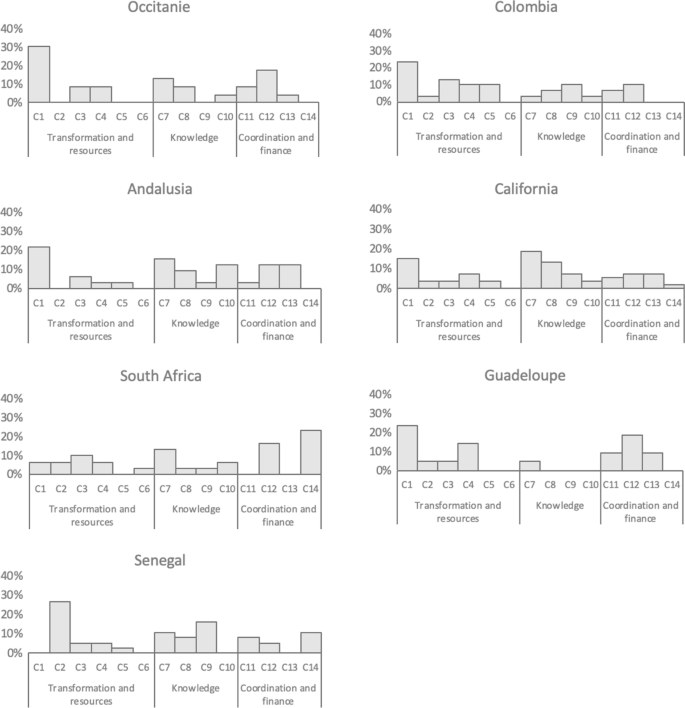
Regarding the agricultural models promoted by policy initiatives, climate-smart agriculture and/or agroecology are the main agricultural models promoted in all the study areas (Fig. 5). It is worth noting that no country or region in our study promoted conventional agriculture as a priority.
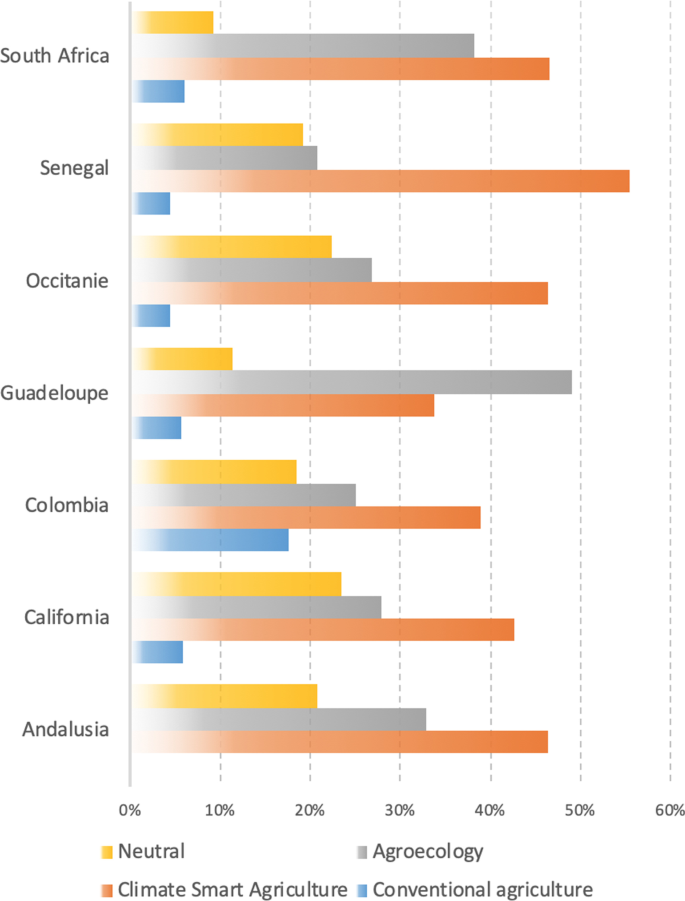
Our study proposed a large-scale map of policy responses to the dangers of climate change for agriculture. Our systematic analysis of 226 policy initiatives in seven regions in the north (Andalusia, Occitanie, California, Guadeloupe) or countries in the south (Colombia, South Africa, Senegal) enabled us to identify 14 climate change adaptation options which mobilize a set of three complementary levers of action: (i) transformation of production systems and access to productive resources, (ii) access to knowledge that is useful for AACC, and (iii) the coordination and financing of adaptation actions at territorial or sector scale.
Past studies have proposed similar inventories and typologies underlining the diversity of climate change adaptation policies and strategic options. For instance, Smit and Skinner (2002) identified four main categories of agricultural adaptation options in Canada: (i) technological developments, (ii) government programs and insurance, (iii) farm production practices, and (iv) farm financial management. Reviewing AACC policy initiatives in West Africa, Zougmoré et al. (2016) found that governments and international donors promote a wide range of climate-smart agricultural options, including cultivar development, water conservation techniques, agroforestry, soil carbon sequestration, seasonal weather and climate forecasting, fertilizer efficiency, and rice water management. Sorgho et al. (2020) conducted a systematic review of policy documents addressing climate change in all 16 West African countries. They found that climate change adaptation policies include development of local risk/disaster plans, microfinance and insurance schemes (public or private), green energy, and development of community groups/farmer organizations. Cooper et al. (2013) reviewed 16 large-scale cases of climate change adaptation/mitigation actions in the agriculture and forestry sectors worldwide. The case studies these authors reviewed included policy and strategy development, insurance, weather information services, and social protection. Finally, IPCC (2022) identified and assessed 9 adaptation categories for the “Food, Fiber and Other” sector: shift in production, policy and planning, livelihood diversification, genetic improvement, collective resource, management, climate services, agronomic management (farm level), agricultural diversification.
The 14 adaptation options we identified in our study of policy initiatives largely converge with past studies. Our results update existing knowledge on AACC policies and broaden the spectrum of identifiable coping strategies. What is more, our study addresses some of the limitations of past studies: (i) most studies used data collected in a single country (Alam et al. 2012; Smit and Skinner 2002) or region (Milhorance et al. 2020; Zougmoré et al. 2016; Schilling et al. 2012; Sorgho et al. 2020); (ii) with the exception of IPCC (2022) and Ulibarri et al. (2022), multi-country studies are relatively old, the most recent one dating from 2013 (Cooper et al. 2013); and (iii) they do not show which agricultural models guide the policies.
Despite the diversity of responses to the problem, one may wonder whether they will be able to bring about sufficiently profound and rapid changes to address the emergency we are currently facing. Current adaptation options may have substantial benefits under moderate climate change, but there are limits to their effectiveness under more severe climate changes (Howden et al. 2007). Moreover, the accumulation of policy tools over time can result in increasingly complex and poorly designed policy mixes, and ultimately lead to policy failure and ineffective public action (Ulibarri et al. 2022). Achievement of AACC depends on the smart combination of appropriate policy initiatives in a coherent and effective policy mix (Lesnikowski et al. 2019; Biesbroek et al. 2015; del Rio and Howlett 2013). Moreover, our results show that coercive policy tools are virtually absent, while policies that work through incentive instruments are preponderant. Other policy initiatives are neutral (cluster 1 of the PCA), meaning they do not favor any particular agricultural model. Under these conditions, it is understandable that AACC relies above all on the good will of the farmers and other food system actors. Yet, many studies have shown that the changes in agriculture that are urgently required are hampered by socio-technical lock-in phenomena that sometimes render transformative policies ineffective (Meynard et al. 2018; Belmin et al. 2018). This conclusion is in line with that of Berrang-Ford et al. (2021), who found that most adaptation initiatives were largely fragmented, local, and incremental, with limited evidence of transformational adaptation and negligible evidence of risk reduction outcomes.
Our analyses show that agroecology (AE) and climate-smart agriculture (CSA) are the preferred models in the mix of policy initiatives in each of the cases we examined. The two models do not conflict with one another; on the contrary, they are often promoted concomitantly. Saj and Torquebiau (2018) found similar results, and argue that beyond the conceptual differences and the sometimes partisan interpretations of these approaches, agriculture needs to take advantage of the potential synergies between AE and CSA. So climate change seems to be reinforcing the place of agroecology and climate-smart agriculture in public agricultural policies at the expense of the usual support for conventional agriculture (CA). Our study is thus the first to show which agricultural models are promoted by policy initiatives at an international level.
Our results show that the mix of policy initiatives and the agricultural models promoted differ significantly from one study site to another. This variability probably reflects the diversity of institutional arrangements and forms of climate vulnerability in the study regions (Table 1). For example, in Senegal, the preponderance of C2 and knowledge-related policy initiatives probably reflects the fact that in the Sahel, the main response to climate change has been to create new irrigation systems and to disseminate information on rainfed agriculture to farmers. In another example, California is the only site where 13/14 categories of adaptation options are represented. This diversity marks a very strong political commitment, in a context where California, a global leader in agriculture, is being hit hard by extreme weather events (fires, drought) (Pathak et al. 2018; Shonkoff et al. 2011).
The orientation of the mix of policy initiatives towards agroecology is most marked in Guadeloupe, while climate-smart agriculture is the path favored by Senegal, Colombia, California, and South Africa, where policies in favor of agroecology are less present, or even missing altogether. The marked orientation of agroecology type initiatives in Guadeloupe can be linked to the French government’s promotion of agroecology, but also to the particular situation in the French West Indies where the chlordecone pollution crisis resulted in strong social pressure. In Senegal, a lower-middle-income country, the promotion of climate-smart agriculture as a way of adapting agriculture to climate change can be explained by the significant influence of the Food and Agriculture Organization, the French Development Agency, and other international organizations in defining public policy and the importance of the food security issue (Nyasimi et al. 2014).
Because of the complexity of the data used (226 initiatives, seven study cases), in order to simplify, we studied only three agricultural models whereas other models could also have been addressed, like nature-based solutions (Hrabanski and Le Coq 2022) or organic agriculture (Reganold and Wachter 2016). However, conventional agriculture, climate-smart agriculture, and agroecology are the three models at the heart of current debates on AACC and more broadly in the future of agriculture in both north and south.
An analysis of impact would have been important, but exceeded our analytical capacity. The questions that need answering are as follows: what have been and are the effects of the policies employed? What impact have they had on the environment (soil, biodiversity, water, etc.)? Are they likely to modify ecosystem services? If so, which? How have they improved the resilience of food and farming systems to climate change? Have they had economic impacts? Have they affected investment in agriculture? Ultimately, very few studies focus on the impact of policy initiatives. While impact is very difficult to assess in advance, an a priori analysis based on intentions would have been useful.
A further limitation is that our study does not include climate change adaptation policies for livestock. Livestock farming is an integral component of agriculture and is particularly vulnerable to climate change. Moreover, the recoupling of agriculture and livestock is recognized as a promising adaptation option to make agricultural systems more resilient and diversified (Rojas-Downing et al. 2017).
Faced with the threat that climate change poses to global agriculture, governments and their technical and financial partners are implementing numerous AACC policy initiatives. We conducted an inventory and a systematic analysis of the AACC policy initiatives in seven case studies, some in countries of the south (South Africa, Senegal, Colombia) and others in regions in the north (Andalusia, Spain; California, USA; Occitanie, France; and Guadeloupe, French West Indies). We sought to identify (1) concrete strategies and levers mobilized by policy initiatives to adapt agriculture to climate change and (2) the agricultural models these policy initiatives promote.
Our results showed that policy initiatives promote a set of 14 different but complementary adaptation options which we classified in the three following categories: (1) policy initiatives to make production systems more sustainable and resilient to climate change and guarantee access to productive resources including water; (2) policy initiatives designed to produce and disseminate knowledge that is useful for stakeholders’ adaptation strategies or coordination between stakeholders; (3) policy initiatives designed to fund adaptation strategies or to coordinate adaptation initiatives at territorial or sector scale.
These findings reveal the consensus on the urgent need for ambitious policies to adapt agriculture to climate change worldwide. Our analysis shows that all the study sites favored agroecology and climate-smart agriculture in their mix of policy initiatives. Hence, climate change appears to be helping in some way to removing the specter of conventional agriculture and to strengthening the place of agroecology and climate-smart agriculture in public agricultural policies.
Our study introduced a new classification of AACC adaptation options, and is the first to show which agricultural models are promoted by policy initiatives on an international level. Future studies should focus on the analysis of ex post impact of these policy initiatives regarding the environmental, economic, and social spheres.
All data generated or analyzed during this study are included in this published article or in the supplementary material. The seven cases/regions reports are available on request.